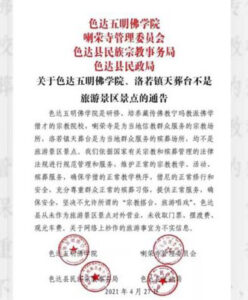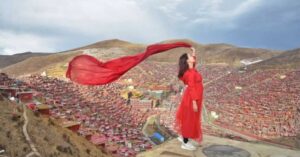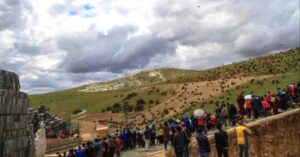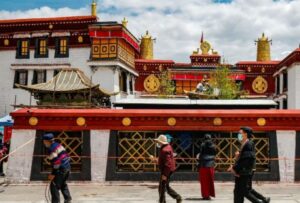
Notice on Larung Gar Buddhist Academy and Nubzig sky burial site
Photo: ICT
The Larung Gar Buddhist Academy and the Nubzig [Ch: Luoruo] sky burial site, both prominent Tibetan Buddhist institutions of religious and cultural significance in Serthar [Ch: Seda] County in eastern Tibet, have issued a public notice which explicitly states that the Academy and the funeral site “are not tourist attractions”. The notice did not issue an outright tourist ban for the two sites.
The International Campaign for Tibet (ICT)* reports that they believe that notice is in defiance of the Chinese tourism industry’s commercialisation of Larung Gar Buddhist Academy and the Nubzig town sky burial site as mystical and exotic travel destinations for Chinese tourists. ICT says that this appears to be a rare accommodation of resistance by the practitioners and the local community over China’s commercialisation of Tibetan Buddhist culture. The notice also reaffirms Larung Gar as a religious institute for training practitioners of the Nyingma school of Tibetan Buddhism, undertaking “normal” religious teachings and activities.
The notice was jointly issued by the Serthar Buddhist College, the Larung Gar Temple Management Committee, the Ethnic and Religious Affairs Bureau of Serthar County and the Serthar County Civil Affairs Bureau on April 27, 2021.

Tourist posing for a picture with the Larung Gar Buddhist Academy as the backdrop
Photo : ICT
ICT states that other challenges continue to limit the academic pursuits of the Tibetan Buddhist community with the monastic community undergoing compulsory “re-education” in Communist Party doctrines. The most recent example was on May 8 when the Serthar Buddhist College announced the launch of a political education drive for party members, cadres and the monastic population of the Academy: the Academy’s Party Committee requires the monastic population to identify themselves with “the great motherland, the Chinese nation, Chinese culture, the Communist Party of China, and Socialism with Chinese characteristics.
Larung Gar Academy was the most important and influential Tibetan Buddhism training in the world before the Chinese authorities started forcibly downsizing it in 2001; it has since halved in size with 5,000 monks and nuns evicted and subjected to political re-education and public humiliation. Six United Nations experts made a submission to China stating that the developments at the Buddhist institute violate international human rights.

Tourists swarming at a sky burial site
Photo: ICT
Jhator or sky burial is the traditional Tibetan funeral practice however, under China’s regime, funeral sites have become a spectacle for Chinese tourists and are routinely included as attraction sites in tour packages. Tourists film the site, ignoring the prohibition against photography.
China promotes tourism in Tibet by stereotyping Tibet and Tibetans politically and socially as exotic and mystical, perpetually singing and dancing, and also pre-modern, barbaric and secessionist under foreign influence.
Meanwhile in Lhasa, the capital of Tibet, Buddhist pilgrims are undergoing severe restrictions on times when they can visit the city’s Jokhang temple, a major pilgrimage site, while tourists are still welcome, reports Radio Free Asia. The authorities have cited COVID-19 concerns as the reason for excluding pilgrims: neighbouring countries India and Nepal are experiencing a spike in cases.
The new edict allows Buddhist worshippers access from 8:00 to 11:30 am, while tourists – who come mainly from China – have access from 12:00 noon to 7:30 pm.

Jokhang temple in Lhasa, Tibet
This month is Saga Dawa, the holy fourth month of the Tibetan lunar calendar and traditionally a time for Buddhists to increase their practice, however the authorities have urged Tibetan Buddhists to limit their practices during Saga Dawa, again citing COVID-19 concerns. Chinese tourists are still welcomed by the authorities to Lhasa despite new COVID variants emerging in major Chinese cities, reports Radio Free Asia, who say that Tourism has surged in Tibet and quoting ICT as saying, “China appears to be using measures to protect the public health as a ‘pretext to continue reducing space for Tibetan Buddhists to practice their faith during this holy month’ […] Moreover, China has refused to stop the flow of Chinese tourists to Tibet, undermining its stated goal of reducing the spread of the virus and adding to the preferential treatment Chinese citizens receive in the Tibetan homeland”.
*The International Campaign for Tibet’s mission is to help Tibetans in their peaceful struggle for democracy and human rights and seek to preserve Tibet’s ancient culture of wisdom.




 Print
Print Email
Email